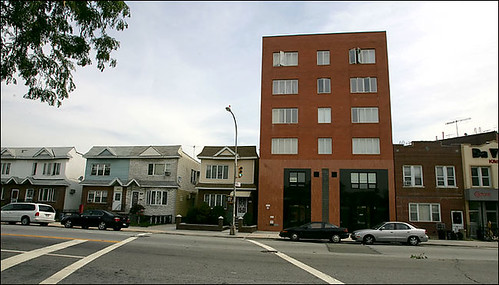The price of in-context vs. out-of-context housing: is it different

Librado Romero/The New York Times. A newly completed residential and professional building on 65th Street in Bensonhurst, Brooklyn, contrasts with the single-family homes on the block. Many building permits have been issued in the area since 2000.
On the pro-urb list there's a thread in relationship to this article, "Inconsistent Effects of a Feature on Home Prices—Lang’s Two-Market Explanation," from Housing Policy Debate, which looks at the question of appropriateness between the transect and type of housing, and property values. I think that this ends up being too facile.
In short, this means that appropriately sized houses and styles according to the density conditions and character of the area will sell for more money than houses that are out of context.
Granted this is from a long thread, so the other responses aren't included, but here's something I wrote about it:
Ironically, this isn't necessarily true either, because you can separate out value of place from the value of the property. In other words, there are many many micromarkets within the broad real estate market, and even within submarkets in the RE market that are seemingly homogeneous, but aren't when it comes to evaluating specific properties and specific buyers.
E.g., I wanted to do a study of a hypothesis on this very point, that out of context and/or "new" houses in the Capitol Hill Historic District sold for less money compared to actual historic houses. See, in the 1970s and 1980s a local developer, Barrett Linde, bought traditional rowhouses (late 1800s Victorians) and tore them down, building faux Colonial Revival houses in their place, BUT usually with ground floor garages. (Providing curb cuts and street front garages wouldn't be allowed today, because there are local historic preservation laws and design guidelines in place.)
But as was pointed out to me, there are people who want to live in (1) a nice neighborhood (2) in DC (3) with access to high quality amenities, (4) frequent transit (5) and still accommodate their car-centric lifestyle, so out-of-context Linde houses were fine with enough buyers to not warrant prices less than more typical historic residential building stock in the Capitol Hill Historic District.
It's a matter of finding the right buyer.
DC proper has at least four types of neighborhoods:
(1) inner core neighborhoods with attached housing and large multiunit buildings, walkable, with neighborhood amenities, subway stations, and relatively high population density, limited onstreet parking, and almost no offstreet parking. (Note that you could consider Downtown, with multiunit apartment and condominium buildings, and no single family dwellings to speak of, to be an additional neighborhood type.)
(2) outer core neighborhoods such as Capitol Hill with attached housing, but very few multiunit buildings, with neighborhood amenities, subway stations, bus transit, with 1/2 the population density of inner core neighborhoods, with onstreet parking and some off street parking;
(3) inner ring neighborhoods with detached housing including rowhouses, duplexes and triplexes, with 33 to 40% of the density of core neighborhoods, with large amounts of onstreet parking, a great deal of off street parking capacity, with access to streetbased transit, and walkable (within one mile) to a subway station;
(4) outer ring neighborhoods, with detached housing, and very few rowhouses, duplexes, or triplexes, infrequent street transit service, large amounts of onstreet and offstreet parking, and no subway stations located within 1-2 miles.
Neighborhood types 3 and 4 are car dependent, even if in type 3 it is quite convenient to live without owning a car (I do).
Rating place, context of building within the transect, transit access, neighborhood amenities, quality of the school district (DC property values are high despite this), etc. are all factors that should be considered, even in an academic study.
Neighborhood review stories in the NYT such as this story on the Norwood neighborhood in the Bronx, and the Baltimore Sun such as this story on the Manchester neighborhood in the suburbs of Baltimore, have an interesting set of criteria. In the NYT, stories include information on these factors:
- neighborhood context and public space amenities
- cost of housing
- schools
- stores and restaurants
- commute
- history
In the Sun, these factors:
- housing stock
- rentals
- crime
- schools
- shopping
- grocery-supermarketing
- restaurants
- nightlife
- recreation/parks
Only by considering all these factors can you really get at this question of what is in the mind of the buyer and what they are buying (paying for). How people weight these various factors determines their choice, regardless of congruence between place characteristics, the mass, height and style of the house, and the location on the transect.
Labels: sustainable land use and resource planning, urban vs. suburban



0 Comments:
Post a Comment
<< Home